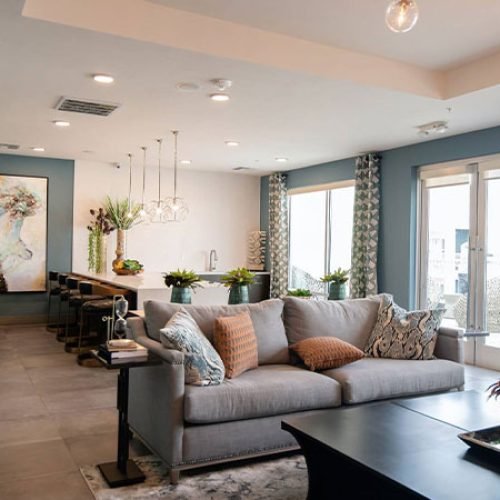LIVING ROOM
A living room in interior design is a central space within a home that serves as a communal area for relaxation, entertainment, and socializing. It is one of the most important rooms in a house, often reflecting the personality and lifestyle of its occupants. Here’s a detailed definition:
Living Room in Interior Design:
The living room is a multi-functional space in a home, designed for comfort, interaction, and leisure. In interior design, the living room is typically the focal point of the house, where design elements are carefully chosen to create a welcoming and aesthetically pleasing environment. The key aspects of designing a living room include:

- 1. Space Planning:
- Layout: The arrangement of furniture and decor in a way that promotes conversation, easy movement, and comfort. Common layouts include symmetrical, asymmetrical, and open-plan designs.
- Zoning: Defining different areas within the living room for specific functions, such as seating areas, media centers, and reading nooks.
- 2. Furniture Selection:
- Seating: Sofas, armchairs, and other seating options are chosen for comfort and style, often centered around a focal point like a fireplace or television.
- Tables: Coffee tables, side tables, and consoles are selected to complement the seating arrangement and provide functionality for holding items like drinks, books, and decor.
- Storage: Cabinets, shelves, and entertainment units are incorporated to store and display items like books, media equipment, and decorative objects.
- 3. Color Scheme and Materials:
- Wall Treatments: The choice of paint, wallpaper, or other wall finishes sets the tone for the room. Neutral tones are often used as a base, with accent colors introduced through furniture and decor.
- Flooring: Hardwood, carpet, rugs, or tiles are chosen based on the desired aesthetic and functional needs, such as warmth and durability.
- Textures: The use of various materials, such as fabrics, wood, metal, and glass, adds depth and interest to the room.
- 4. Lighting Design:
- Ambient Lighting: General lighting, such as overhead fixtures or recessed lights, provides overall illumination for the room.
- Task Lighting: Lamps and other focused lighting sources are used to enhance activities like reading or working on a laptop.
- Accent Lighting: Decorative lighting, such as wall sconces or floor lamps, highlights artwork, architectural features, or key design elements.
- 5. Decor and Accessories:
- Art and Wall Decor: Paintings, prints, mirrors, and other wall art are chosen to enhance the room’s aesthetic and reflect the occupants’ tastes.
- Textiles: Cushions, throws, curtains, and rugs are used to add color, texture, and comfort to the living room.
- Plants and Greenery: Houseplants and flowers bring life and a natural element into the space, contributing to the overall ambiance.
- 6. Focal Points:
- Fireplace or Media Center: Often, the living room is designed around a central feature, such as a fireplace or a television, which becomes the main gathering point.
- Views: Large windows or glass doors that offer views of the outdoors can also serve as a focal point, bringing in natural light and creating a connection with nature.
- 7. Style and Theme:
- Design Style: The living room’s style can range from traditional to modern, minimalist to eclectic, depending on the desired look and feel. The chosen style guides the selection of all elements in the room, from furniture to decor.
- Cohesion: The design of the living room should be cohesive, with all elements working together to create a harmonious and balanced space.
- 8. Functionality:
- Multi-Use Spaces: In some homes, the living room may double as a home office, guest room, or play area. In such cases, the design must accommodate these additional functions without compromising the room’s primary purpose.
- Comfort and Usability: Above all, the living room should be a comfortable and inviting space that suits the daily activities of its users.
In interior design, the living room is often the most publicly visible part of a home, and as such, it is designed to make a strong impression while also being a practical, comfortable space for everyday life.
